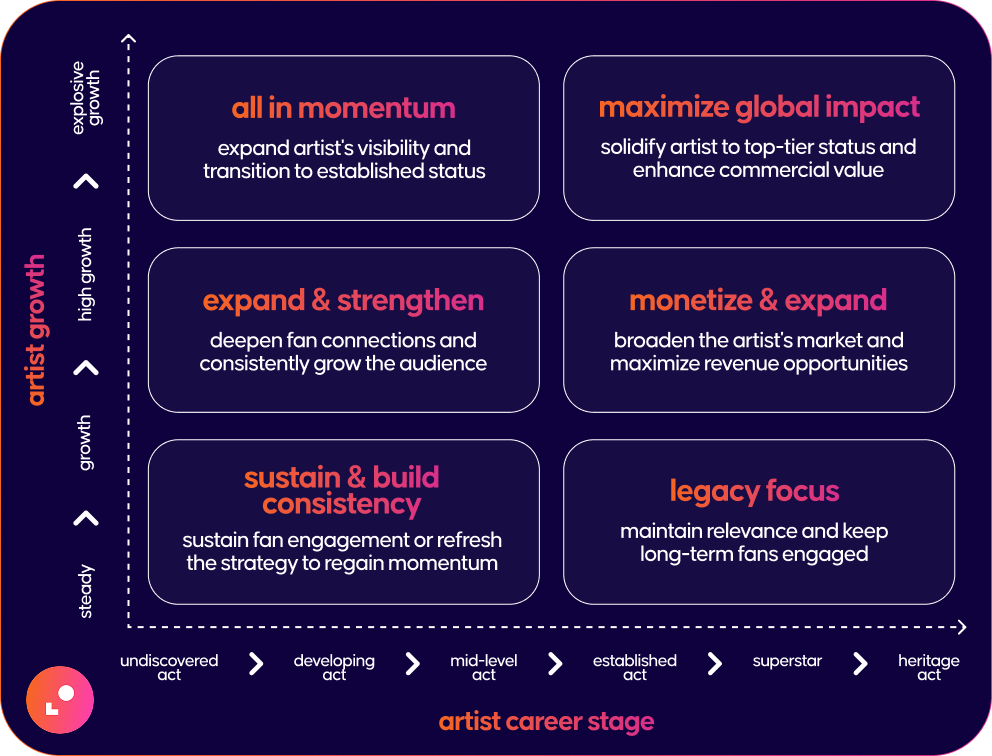A data-driven approach to music marketing for every type of artist — from undiscovered to heritage — focused on understanding your career stage and growth momentum to create the right strategy and build effective campaigns.
In today’s complex digital music ecosystem, indie artists and labels often struggle to gauge their true market position and career trajectory among millions of competing musicians. Chartmetric has developed a sophisticated yet accessible system to help artists understand their career stage and growth patterns, offering valuable benchmarks for those navigating the industry independently. This categorization system provides a data-driven approach to measuring artist development that is particularly valuable for indie artists looking to make strategic decisions about their careers.
Understanding the Music Career Ladder
Chartmetric’s approach builds upon the academic work of Terry R. Tompkins, a music educator and former Columbia Records A&R executive who discovered John Legend. In his 2019 study, Tompkins established a six-stage career progression framework that provides a comprehensive roadmap of an artist’s journey.
The journey begins with Stage 1, the “Undiscovered Act,” characterized by artists performing locally with minimal track record, low streaming numbers, and no established professional team. Most indie artists begin here, focusing on building a local following and initial online presence.
Moving up, Stage 2 identifies the “Developing Act,” where artists typically establish a regional touring base, play venues with 300-500 capacity, and may have signed to a label. At this stage, indie artists often secure a booking agent and begin developing a social media presence, though they may remain self-managed.
Stage 3 represents the “Mid-Level Act,” marked by one largely successful release or multiple consistent sellers. These artists tour venues with 500-3,500 capacity and have built anticipation for their next releases among fans and industry professionals alike. Many established indie artists operate at this tier, balancing creative control with growing business operations.
As artists progress to Stage 4, the “Established Act,” they develop a fully formed core fanbase, release multiple successful projects, tour internationally, and play venues with 5,000-10,000 capacity. While recognizable, they haven’t yet achieved superstardom. For independent labels, having artists reach this level often signifies a major achievement.
The pinnacle stages include Stage 5, “Superstar Act,” featuring platinum records and arena tours, and Stage 6, “Heritage Act,” representing established artists with long-standing fanbases who often operate independently of traditional label structures.
Chartmetric’s data-driven approach
Building on Tompkins’ framework, Chartmetric created its own quantitative system using its proprietary Artist Score as the foundational metric. The Chartmetric Artist Score serves as a global popularity index that updates daily, reflecting the dynamic nature of an artist’s digital presence across platforms.
What makes Chartmetric’s quantitative system particularly
valuable for indie artists is how it condenses over 50 metrics
from 16 social media and streaming platforms into one
comprehensive number. This provides a holistic view of digital
performance without requiring artists to manually track dozens
of separate analytics dashboards.
The accompanying Chartmetric Artist Rank contextualizes this score by showing how artists compare to millions of others in the Chartmetric database. For indie artists, this provides a crucial perspective on their relative position in the crowded digital marketplace.
The five career stages according to chartmetric

Chartmetric adapts Tompkins’ model into five distinct career stages based on the median of an artist’s past 360 days of Artist Score. This long-term view intentionally filters out temporary spikes or dips to capture an artist’s consistent performance level.
For indie artists, understanding these categories provides realistic benchmarking:
- Developing: This category encompasses the vast majority of artists, including those building their initial following. Most independent artists begin and operate within this category, focusing on breaking through to higher tiers.
- Mid-level: Artists ranking between 8,000-30,000 by Artist Score fall into this category. Many successful indie artists operate here, building sustainable careers while maintaining creative independence.
- Mainstream: Representing artists ranked 2,000-8,000, this category includes those who have achieved significant recognition while potentially still operating independently or with indie labels.
- Superstar: The top 1,200 artists with releases in the past 30 years occupy this rarified tier. While challenging for truly independent artists to reach, some indie artists who maintain ownership while securing major distribution or service deals can achieve this level.
- Legendary: Reserved for the top 1,200 artists with catalogs older than 30 years, this category represents established cultural icons with enduring influence.
One size does not fit all: our digital strategy matrix

When it comes to building a successful music career, timing is everything and so is strategy. Understanding an artist's career stage and momentum is essential for designing effective digital marketing campaigns. This allows us — and you — to match the right strategy to the right moment.
The Digital Strategy Matrix is a tailored framework we use to design growth strategies for music artists, recognizing that “one size does not fit all.” Adapted from Chartmetric’s Artist Career Stage model, it maps an artist’s career stage (from “Undiscovered” to “Heritage”) against their growth trajectory (from “Steady” to “Explosive”). Each quadrant reflects a specific digital strategy objective—from building consistency for early-stage acts to maximizing global impact for rising superstars.
At both Ranked and catapult°, we use this matrix as a diagnostic and planning tool. An “Undiscovered” act with steady growth, for example, needs foundational work: tightening digital presence, engaging locally, and defining brand identity. As growth accelerates and the artist becomes “Developing” or “Mid-Level,” we shift to strategies that deepen audience engagement and broaden market reach — leveraging platform data, influencer marketing, and targeted content. For “Established” and “Superstar” artists, we prioritize monetization, cross-platform brand integration, and international scalability.
Finally, artists in the “Heritage” stage benefit from a “Legacy Focus” approach, sustaining relevance while optimizing catalog performance and reconnecting with core fans.
And for every artist, at every stage, sustaining and building consistency remains critical. Whether you're bouncing back or gearing up for your next wave, keeping fans engaged is key. No matter where you stand in your journey, the right strategy is the one that meets you exactly where you are.
This matrix ensures we’re not applying cookie-cutter plans, but instead creating actionable roadmaps aligned with each artist’s unique journey and growth pace.
Measuring short-term momentum
Particularly relevant for indie artists is Chartmetric’s Artist Growth metric, which measures short-term momentum by comparing the past 30-day average Artist Score with the past 60-day average. This provides insight into whether recent promotional efforts, releases, or social media campaigns are generating traction.
Importantly, Chartmetric calculates growth relative to artists within the same Career Stage, ensuring that developing artists aren’t measured against already established superstars. This creates fairer benchmarks for indie artists at various career phases.
The five growth categories—Explosive growth (8+ standard deviations above mean), High growth (3-8 standard deviations), Growth (approximately 3 standard deviations), Even (around the mean), and Decline (below average) — provide clear indicators of an artist’s current trajectory.
Strategic applications for indie artists and labels

For independent artists and labels, these metrics offer several practical applications:
Realistic Goal Setting: Understanding the typical characteristics of each career stage helps indie artists set achievable milestones rather than comparing themselves to mainstream stars with major label resources.
- Resource allocation: By tracking which promotional efforts correlate with measurable growth, indie artists can better allocate limited budgets to activities that demonstrate actual return on investment.
- Team building decisions: The framework provides guidance on when to expand an artist’s professional team, such as when venue capacities suggest it’s time to add a booking agent or when financial complexity warrants a business manager.
- Investor and partner presentations: Independent labels can use these metrics when seeking funding or distribution partnerships, demonstrating an artist’s growth pattern with objective data rather than subjective promises.
- Career transition planning: The system helps identify when artists might be ready to transition between stages, such as expanding from regional to national touring or moving from digital-only to physical releases.
Conclusion
For indie artists navigating the complexities of the music industry, Chartmetric’s Artist Career Stage and Growth system provides valuable structure and benchmarking tools. While major label artists benefit from established industry infrastructure and resources, independent artists must make strategic decisions with limited information and resources.
These metrics help transform subjective career assessment into data-driven strategy, allowing indie artists and labels to track progress, identify opportunities, and allocate resources more effectively. By understanding where they stand in the broader music ecosystem and monitoring growth patterns, independent artists can make more informed decisions about their career development, marketing efforts, and business partnerships.







